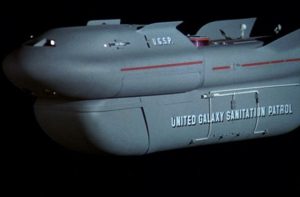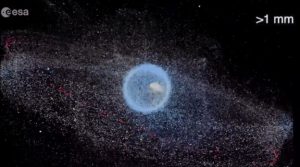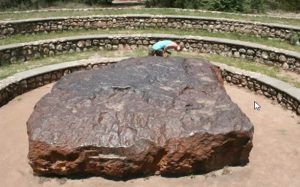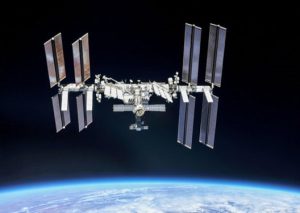6 Trash Collection and Tracking in Space (Hood & Lonstein)
Student Learning Objectives
This chapter examines the problem of trash in space, including its history, exploring how space junk is located and tracked. Potential mitigation strategies are presented and discussed. Though rarely discussed, the safety considerations of those traveling in space and those on Earth are enormous, not to mention the environmental impact trash in space has both outside and within the Earth’s atmosphere. Through understanding historical considerations of waste management and the challenges presented on Earth, we hope to provide students with a foundational understanding of the issues they will confront when applying them to extraterrestrial environments.
The History of Trash
Famed MIT inventor, futurist, and engineer Carlo Ratti once said, “Some trash is recycled, some are thrown away, and some ends up where it should not end up.” (Ratti, 2022)
In the 1960s and 70s, space travel and exploration were what many of our dreams were made of. Beginning with Sputnik, then the moon, mars, and beyond. While many of us dreamed of what could and may be possible, other visionaries foresaw that no matter where humans travel, they inevitably will need to address the issue of hygiene and waste management. According to many scholars, the ancient Greeks and Romans began to address the issue of trash as early as 3000 BC, when the first known landfill was created on the island of Crete, followed by the Chinese, who began to compost and recycle around 2000 BC. (Agnoletti & Serneri, 2016)
Most early forms of waste management involved the collection of trash and removing it to waste pits located outside cities. This initial waste management method helped address space and transportation concerns in densely populated cities. Plagues during the fourteenth through eighteenth centuries devastated large portions of the world’s population, and waste management’s objectives were refocused upon health. (Nathanson, 2020)
As the industrial revolution hit its stride in the 19th and 20th centuries, waste production increased exponentially, requiring more sanitation methods and technologies. Incineration, community collection, and sanitary forms of landfill disposal played a vital role in supporting the faster, bigger, more affluent new world. (Hoornweg & Gianelli, 2007)
Figure 6-1: Ancient Greece Trash Pit (Eastern Boeotia Archaeological Project)

Source: (Hall, 2015)
While simple in its operation, the trash pit in Figure 6-1 was largely effective due to the force of gravity. Most trash placed in the pit was of sufficient weight that it would be difficult for the wind or other elements to overcome the gravitational force holding within the pit. Additionally, when a cover of wood or stone capped the pit, gravity again assisted in keeping the trash in place. (Harvey, 2021) As we turn to this issue of debris and other refuse outside of the Earth’s atmosphere, the benefits provided by gravity are far less significant.
The Challenge of Orbital Debris in Space
Famed poet and playwright Oscar Wilde once wrote, “Life imitates Art far more than Art imitates Life” (Wilde, 2022). Many of us who grew up in the 1970’s recall a relatively obscure television comedy called “Quark.”
Figure 6-2: Quark TV Show Space Sanitation Vehicle (Courtesy Columbia)

Source: (Weiner, 2019)
The short-lived comedy bore the name of the lead character Adam Quark. The idea of quirky writers foresaw an issue many years later, which would require outer space sanitation technology. Fast forward fifty years to 2022, and Buck Henry, the writer who created Quark, has gone from comic to visionary.
How significant is the problem of space debris? Dr. Joseph Minow put it this way in 2015:
“Micrometeoroids and orbital debris (MMOD) is the number one risk
for NASA’s human space flight programs. Many orbital debris objects
—approximately 20,000—are large enough to be tracked and cataloged
by the U.S. Space Surveillance Network and can be avoided by
spacecraft maneuvering. But the unseen population of MMOD
poses the biggest risk to spacecraft: the orbital debris large enough to
cause damage, but too small to track, and the micrometeoroids, which
can’t be tracked regardless of their size.” (Minow, 2016)
Dr. Minow also points to the reality that one of the greatest challenges for space vehicles again relates to the force of gravity. “Getting to space requires speed. A lot of speed. So, for NASA to send an object, like a satellite, into orbit, that object must reach velocities of several kilometers per second. And if it hits anything while in orbit, like debris, the damage can be substantial if not catastrophic.” (Minow, 2016)
Factors including speed, congestion, and road hazards (debris) are well-established causative factors in modern society’s fatalities on the roads and highways. According to the National Highway Traffic Safety Administration (NHTSA) conducted, in 2020, speed was a factor in 29% of all highway fatalities on U.S. roadways. The toll of human lives lost related to speed in just one year alone was 11,258 in 2020. (National Highway Traffic Safety Administration, 2022). Similarly, road debris plays a significant role in highway accidents and fatalities. According to the American Automobile Association, “Between 2011-2014, road debris was a factor in a total of more than 200,000 police-reported crashes resulting in a total of approximately 39,000 injuries and 500 deaths.” (American Automobile Association Foundation for Traffic Safety 2016) Finally, that congestion and accidentality are highly correlated. (Sánchez González, 2021)
While the roads many of us travel daily may seem somewhat challenging, imagine a traffic jam in a zero-gravity environment. On Earth, we usually concern ourselves with oncoming traffic or obstacles in our front, rear, right, and left. In space, other traffic can approach from above and below as well. Further complicating things is velocity. According to NASA:
“There are approximately 23,000 pieces of debris larger than a softball orbiting the Earth. They travel at speeds up to 17,500 mph, fast enough for a relatively small piece of orbital debris to damage a satellite or a spacecraft. There are half a million pieces of debris the size of a marble or larger (up to 0.4 inches, or 1 centimeter) or larger, and approximately 100 million pieces of debris-about .04 inches (or one millimeter) larger. There is even smaller micrometer-sized (0.000039 of an inch in diameter) debris.
Even tiny paint flecks can damage a spacecraft when traveling at these velocities. Several space shuttle windows were replaced because of damage caused by material analyzed and shown to be paint flecks. Millimeter-sized orbital debris represents the highest mission-ending risk to most robotic spacecraft operating in low Earth orbit.” (NASA, 2021)
According to Secure World, there are three main challenges confronting the safe and sustainable use of outer space, Space Junk. Orbital Crowding and Space Security. Separately, each of these challenges represents an existential threat to both manned and unmanned orbital operations; many believe the current situation is already unsafe and worsening with every launch of new vehicles.
Figure 6-3: Space Sustainability (Courtesy Sustainable World Foundation)

Source: (Secure World Foundation, Bhutada, Govind Editor, 2021)
Orbital debris presents a multitude of challenges both on Earth and in space. In her recent book, “War in Space,” Linda Dawson explores the use of space debris as a weapon of war. Many, including Dawson, believe we are approaching the Kessler syndrome. The Kessler syndrome is akin to a chain reaction where objects in space collide, creating more debris. The newly created debris will cause more collisions, and a nuclear reaction-like process will eventually lead to a time when “low Earth orbit is so full of debris that passage through it becomes impossible.” (Dawson, 2018)
Figure 6-4: Lab Test Result Small Aluminum Ball Hitting Aluminum Block at 7 KM per second (Courtesy Scientific American and ESA)

Source:(David, 2021)
The devastation that can occur from collisions in space between vehicles and man-made and naturally-occurring debris is unfathomable. While we have documented many minor collisions so far, we have not witnessed a collision between two spacecraft, orbit vehicles, or larger debris or meteor. Given the immense force created by such collisions, it is only logical to consider the use of debris as a tool of warfare. While many private companies and governments are beginning to address the removal of space debris, the reality is that a darker side of debris exists, one where it is used as a tool for war, terror espionage, or another hostile purpose. Dawson points out that “There is a double-edged sword to the (debris removal) technology that might solve this issue, as anything that can be used to bring down unusable satellites can also bring down active ones.” (Dawson, 2018) p. 60.
Figure 6-5: Visualization of space debris around Earth (Courtesy ESA)

Source: (European Space Agency, 2019)
Space debris has ramifications both outside of Earth’s atmosphere and at every level within it. As mankind continues to explore, understand, and use space as a resource, inevitably, we will leave our mark upon it. Sadly, part of that mark is trash. For example, in 2021, a Falcon 9 rocket pressure vessel fell onto a farm in central Washington State. Luckily no injuries occurred.
Figure 6-6: Falcon 9 Rocket Pressure Tank (Courtesy Grant County Sheriff via Twitter)

Source:(Grant County Washington Sheriff, 2022)
Since the launch of the former Soviet Union’s Sputnik in 1957, humans have been adding to the pre-existing bounty of galactic byproducts generally referred to as Asteroids and Meteoroids. According to NASA, an asteroid is a small rocky body that orbits the Sun. When asteroids collide, debris can scatter; these collision byproducts are called meteoroids. Meteoroids can also come from comets but are not composed of rock but dust and ice. When a meteoroid comes near or in contact with Earth’s atmosphere, it is called a meteor. Meteors often appear as streaks of light in a dark sky, sometimes called “falling stars.” When a meteor or some portion of it makes it through Earth’s atmosphere and falls to Earth, it is called a meteorite. (NASA, 2022) The largest known example of a meteorite known as Hoba is believed to have landed in what is known today as Namibia, weighs approximately 60 tons, and is believed to have landed some 80,000 years ago.
Figure 6-7: Hoba (Courtesy Compl33t / Wikimedia Commons)

Source: (Dodgson, 2017)
Figure 6-8: Space debris consists of discarded launch vehicles or parts of a spacecraft that float hundreds of miles above Earth. Image: Space Safety (World Economic Forum, 2021)

Current International Policy and Laws on Space Trash
The body of legal regulations regarding the use of space (space being defined as the area above the jurisdiction of air law) by public and private entities are referred to as space law. Currently, there are only about five such regulations of space, the most significant of those being the United Nations Treaty on Principles Governing the Activities of States in the Exploration and Use of Outer Space, including the Moon and Other Celestial Bodies (from now on referred to as the Outer Space Treaty) of 1967. In this article, I would like to specifically describe and analyze the laws and regulations handling the increasingly prevalent issue of space debris in orbit around Earth. The National Aeronautics and Space Administration (NASA) defines space debris as “any man-made object in orbit about the Earth which no longer serves a useful function.” [1] However, a major confusion discussed below is that the Outer Space Treaty does not explicitly define what it refers to as “space objects,” nor does it mention whether space debris is space objects. An excessive clustering of space debris is a problem for a few reasons. It may result in a phenomenon known as the Kessler Syndrome, in which a “cascade created when debris hits a space object, creating new debris and setting off a chain reaction of collisions that eventually close off entire orbits.” [2] This endangerment of Earth’s future ability to explore extraterrestrial planets and life must be avoided at all costs. Furthermore, space debris in orbit around Earth limits the amount of available space for satellites to orbit, which may result in the Tragedy of the Commons: multiple actors will aggressively vie, in an arms race, for their right to space as it is a limited resource. (Shah, 2021)
Recent accidents that continue to clutter the orbital space around Earth: ISS Swerves
MOSCOW, December 3 (Reuters) – The International Space Station (ISS) had to swerve away from a fragment of a U.S. launch vehicle on Friday, the head of Russia’s space agency said, the latest in a series of incidents in which space debris have forced astronauts to respond. (Reuters, 2021)
In recent years there has been an uptick in expressed concern from recent emergency procedures carried out by the ISS. The below excerpt describes one such incident from 2021:
Since Russia conducted an anti-satellite missile test last month, calls to monitor and regulate space debris, or space junk, have grown. This generated a debris field in orbit that U.S. officials said would pose a hazard to space activities for years. (Reuters, 2021)
Figure 6-9: The International Space Station photographed from Russian spacecraft after undocking.

Source:(Reuters, 2021)
Dmitry Rogozin, head of Russian space agency Roscosmos, said that the ISS had been forced to move due to space junk from a U.S. launch vehicle sent into orbit in 1994.
Roscosmos said the station’s orbit, in an unscheduled maneuver, carried out by mission control, dropped by 310 meters (339 yards) for nearly three minutes to avoid a close encounter. Rogozin added that the maneuver would not affect the planned launch of the Soyuz MS-20 rocket on December 8 from the Baikonur Cosmodrome in Kazakhstan and its docking at the ISS. (Reuters, 2021)
Looming changes that may further destabilize international space operations add more clutter to an already dirty problem: Russia leaves ISS.
MOSCOW — Russia will pull out of the International Space Station after 2024 and focus on building its orbiting outpost, the country’s new space chief said Tuesday, amid high tensions between Moscow and the West over the fighting in Ukraine. Yuri Borisov, appointed this month to lead the state space agency, Roscosmos, said during a meeting with President Vladimir Putin that Russia will fulfill its obligations to its partners before it leaves. (Associated Press, 2022)
“The decision to leave the station after 2024 has been made,” Borisov said, adding: “I think that by that time, we will start forming a Russian orbiting station.” (Associated Press, 2022)
NASA and other international partners hope to keep the space station running until 2030, while the
Russians have been reluctant to make commitments beyond 2024. (Associated Press, 2022) NASA has been working with U.S. companies to eventually establish private space stations to replace the International Space Station. NASA hopes these commercial space stations will be up and running by the decade’s end. (Associated Press, 2022)
Clean This Mess: The Kessler Syndrome and the challenges of cleaning orbital space debris before it’s too late.
Finding ways to remove at least some of all that space junk should be a top global priority, says Donald Kessler, a retired NASA senior scientist for orbital debris research. In the late 1970s, he foretold the possibility of a scenario dubbed the Kessler syndrome. As the density of space rubbish increases, a cascading, self-sustaining runaway cycle of debris-generating collisions can arise that might ultimately make low-Earth orbit too hazardous to support most space activities. (David, Leonard, 2021)
A Space Age “tragedy of the commons” is unfolding right under our nose—or right over our head—and no consensus yet exists on how to stop it. For more than a half-century, humans have been hurling objects into low-Earth orbit in ever-growing numbers. And with few meaningful limitations on further launches into that increasingly congested realm, the prevailing attitude has been persistently permissive. In orbit, it seems, there is always room for one more. (David, Leonard, 2021)
“There is now agreement within the community that the debris environment has reached a ‘tipping point where debris would continue to increase even if all launches were stopped,” Kessler says. “It takes an Iridium-Cosmos-type collision to get everyone’s attention. That’s what it boils down to…., And we’re overdue for something like that to happen.” (David, 2021)
Kelso says there is no “one-size-fits-all solution” to the space junk problem. He observes that removing large rocket bodies is a significantly different task than removing the equivalent mass of many smaller objects, which are in a wide range of orbits. Meanwhile, innovations by companies such as SpaceX are dramatically lowering launch costs, opening the floodgates for far more satellites to reach low-Earth orbit, where some will inevitably fail and become drifting, debris-generating hazards (unless ELSA-d-like space tugs remove them). “Many of these operators are starting to understand the difficulty and complexity of continuing to dodge the growing number of debris.” (David, 2021)
For now, according to Moriba Jah, an orbital debris expert at the University of Texas at Austin, the business case for space debris removal is not monetizable and is more a “PowerPoint talk” than a real marketplace. (David, 2021)
“I think people are hoping that government comes to some common sense to help create and establish a marketplace for industries to engage in these sorts of activities,” Jah says. For that to happen, he believes that spacefaring nations have to agree that near-Earth space is an ecosystem like land, air, and the ocean. “It’s not infinite, so we need environmental protection,” he says. (David, 2021)
Jah has in mind space sustainability metrics akin to a carbon footprint. “Let’s call it a ‘space traffic’ footprint,” he says. “We need a way to quantify when an ‘orbital highway’ gets saturated with traffic, so it’s not usable. Then you can assign a bounty for objects and discuss nonconsensual debris removal. Maybe there is a penalty to the sovereign owner of their dead asset that’s taking up the capacity of an orbit. This could create a marketplace where space-object-removal technologies can thrive.” (David, 2021)
A classification scheme for objects in space is also needed. Having such a taxonomy, Jah says, would help sort out what types of technologies are required for removing different pedigrees of orbital clutter. As for the big picture, Jah says it is a simple numbers game: the rate of launches exceeds the rate of space objects reentering Earth’s atmosphere. “That’s not a great kind of energy balance,” he adds. (David, 2021)
Alas, Jah says, policymakers are still sluggish in their reactions to the problem. After all, although events such as the 2009 Cosmos-Iridium collision generate massive amounts of debris, they are still quite rare—for now. (David, 2021)
“In my view, that 2009 collision was equivalent to passengers on the Titanic feeling that bump from an iceberg, and then there’s a band playing on the deck,” Jah says. “In terms of hazardous orbital debris, things are already going a detrimental way because we haven’t changed our behavior.” (David, 2021)
QUESTIONS:
- As a space navigation professional, you are tasked with flight planning just as in commercial aviation within the Earth’s atmosphere. What resources do you think will be needed to be able to safely navigate your entire journey as it relates to naturally occurring and man-made space debris?
- Besides both types of space debris and direct kinetic attack, can you foresee any other type of attack vector being used in space related to waste or biological products? (Hint air, water, filtration, food, medication)
- What could current technologies be used to create a potential low-cost solution to cleaning space debris? What resource considerations and policies would need to be considered and or created to help facilitate the removal of space debris?
References
Agnoletti, M., & Serneri, S. (2016). The Basic Environmental History. In M. Agnoletti, & S. Serneri, The Basic Environmental History (pp. 201-204). Florence: Springer.
American Automobile Association Foundation for Traffic Safety. (2016, August). The Prevalence of Motor Vehicle Crashes Involving Road Debris, United States, 2011-2014. Retrieved from AAA Foundation for Traffic Safety: https://aaafoundation.org/prevalence-motor-vehicle-crashes-involving-road-debris-united-states-2011-2014/
Associated Press. (2022, July 26). Russia says it will quit the International Space Station after 2024. Retrieved from NPR: https://www.npr.org/2022/07/26/1113683450/space-station-iss-russia-leaving-2024
David, L. (2021, April 14). Space Junk Removal Is Not Going Smoothly. Retrieved from Scientific American: https://www.scientificamerican.com/article/space-junk-removal-is-not-going-smoothly/
David, Leonard. (2021, April 14). Space Junk Removal Is not Going Smoothly. Retrieved from Scientific American: https://www.scientificamerican.com/article/space-junk-removal-is-not-going-smoothly
Dawson, L. (2018). War in Space. New York: Springer.
Dodgson, L. (2017, February 23). The biggest meteorites in history have plummeted to Earth and survived. Retrieved from Business Insider: https://www.businessinsider.com/biggest-meteorites-space-junk-crashed-earth-2017-2
European Space Agency. (2019, September 19). ESA commissions the world’s first space debris removal. Retrieved from European Space Agency: https://www.esa.int/Space_Safety/Clean_Space/ESA_commissions_world_s_first_space_debris_removal
Grant County Washington Sheriff. (2022, July 18). What goes up must come down: The study looks at the risk of orbital debris casualties. Retrieved from Space.Com: https://www.space.com/space-junk-rocket-debris-reentry-risk
Hall, A. R. (2015). “Sewers, cesspits, and middens: A survey of the evidence for 2000 years of waste disposal in York, UK,”. Sanitation, Latrines and Intestinal Parasites in Past Populations, ed. P. D., 99-119. Retrieved from EBAP Excavations.
Harvey, M. (2021, May 21). TRASH OR TREASURE? A MEDIEVAL PIT FROM ELEON. Retrieved from EBAP EXCAVATIONS: https://ebapexcavations.org/2021/05/21/trash-or-treasure-a-medieval-pit-from-eleon/
Hoornweg, D., & Gianelli, N. (2007, October). Managing municipal solid waste in Latin America and the Caribbean:: Integrating the private sector, harnessing incentives. Gridlines, pp. 1-5.
Minow, D. J. (2016, July 11). Space Debris: Understanding the risks to NASA Spacecraft. Retrieved from NASA.
NASA. (2021, May 26). Space Debris and Human Spacecraft. Retrieved from NASA: https://www.nasa.gov/mission_pages/station/news/orbital_debris.html
NASA. (2022, July 28). Asteroid or Meteor: What’s the Difference? Retrieved from Space Place: https://spaceplace.nasa.gov/asteroid-or-meteor/en/
Nathanson, J. A. (2020, November 10). Solid-Waste Management. Retrieved from Encyclopedia Britannica: https://www.britannica.com/technology/solid-waste-management
National Highway Traffic Safety Administration. (2022, August 10). Speeding. Retrieved from NHTSA: https://www.nhtsa.gov/risky-driving/speeding#nhtsa-in-action
Ratti, C. (2022, August 5). carloratti.com/publications/. Retrieved from Carlo Ratti Associates: https://carloratti.com/publications/
Reuters. (2021, December 3). Reuters. Retrieved from Reuters Online: https://www.reuters.com/lifestyle/science/international-space-station-swerves-dodge-space-junk-2021-12-03/
Sánchez González, S. (2021). Understanding the Effect of Traffic Congestion on Accidents. Washington, D.C.: Transport Division, Inter-American Development Bank.
Secure World Foundation, Bhutada, Govind Editor. (2021, October 6). Space Sustainability: Preserving the Usability of Outer Space. Retrieved from Visual Capitalist: https://www.visualcapitalist.com/sp/space-sustainability-preserving-the-usability-of-outer-space/
Sedgwick, T. (1826). Hints to My Countrymen. New York: J. Seymour.
Shah, S. (2021, August 30). August 30: The International Legal Regulation of pace Debris. Retrieved from Cornell Undergraduate Law and Society Review: https://www.culsr.org/articles/the-international-legal-regulation-of-space-debris
Weiner, D. (2019, January 1). An Ode To ‘Quark’: Richard Benjamin Remembers His Brief but Beloved Sci-Fi Sitcom. Retrieved from It Came From: https://itcamefromblog.com/2019/01/21/an-ode-to-quark-richard-benjamin-remembers-his-brief-but-beloved-sci-fi-sitcom/
Wilde, O. (2022, August 7). The Decay Of Lying: An Observation. Retrieved from The Literature Network: http://www.online-literature.com/wilde/1307/
World Economic Forum. (2021, November 24). Should We Be Worried About Space Debris? Retrieved from Space: https://www.weforum.org/agenda/2021/11/space-debris-satellite-international-space-station

